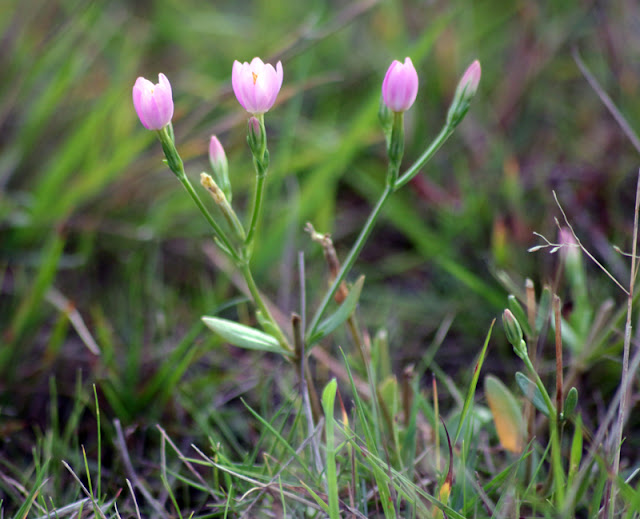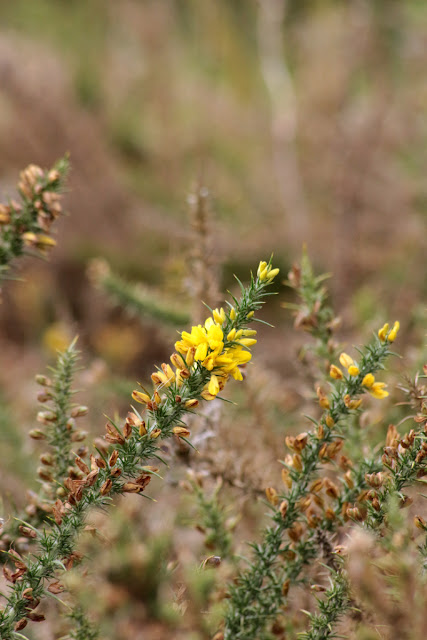Dartford Heath, Kent - 24/10/17
This ancient heath in North Kent is now virtually surrounded by urbanisation, but it still holds several rare and threatened species, such as Upright Chickweed and Petty Whin. Being well into Autumn I didn't expect to find much of note, but as usual I was wrong!
Michelmas Daisies aren't hard to spot, however, it can be tricky working out which type of Aster they are, and this day I didn't have time to do that.
Aster agg.
These were well into the heath away from the car park, so they may have naturalised there from wind blown seed from the urban gardens less than a mile away.
Here's one of those difficult to determine yellow crucifers from the Cabbage Family.
It's leaves showed it was definitely one of the Rockets, but which one?
Thankfully, there were plenty of seeds. These are often vital to make a firm ID and make it much easier to do so.
Look closely at where the pod meets the pod stem. There's a small gap between the pod and stem showing this to be Perennial Wall Rocket.
Other Rockets don't have this gap.
Diplotaxis tenuifolia
In the more acidic areas, there was plenty of Heather and Bell Heather, all in seed.
So I picked a couple and placed them side by side for comparison, with Bell Heather on the left and Heather on the right
I had hoped I might still find some in flower, so I kept on looking.
I failed to find any flowerinf Heather, but I did find several Bell Heathers still going strong on another part of the heath.
Erica cinerea
Some splashes of colour were in a hedgerow, with the appropriately named Hedgerow Cranesbill providing it. Superficially, it looks very similar to Dovesfoot Cranesbill, but the whole plant is much bigger, more erect and with much larger flowers than Dovesfoot.
Geranium pyrenaicum
Hypochaeris radicata
Cat's Ear was present along a road verge adjoining the heath.
This is relatively easy to tell apart from similar species with the most obvious feature being small scale like bracts up the flower stem with a solitary flower on top.
Other species don't have these scales on the stem.
This one was helping out an Autumn Marmalade Hoverfly.
I was rather surprised to find this beefy looking Prickly Lettuce as I'd not seen one for a while, all having gone to seed elsewhere and withered away.
There were flower buds present, but none were open. For such a big plant, it has very small Dandelion like flowers, but lots of them in big sprays above the leaves.
Incidentally, the leaves on this species rotate throughout the day to face the sun!
Lactuca serriola
Here's another non-flowering plant. I looked long and hard for a flower as they are beautiful, though very small, but I failed this time. This is Birdsfoot, which produced white, yellow and red flowers in late Spring. It likes sandy soils and was abundant on parts of the heath.
Ornithopus perpusillus
Just so you know what to look for, here's one in flower on the heath from May 2016. Note that the flowers are probably only 5mm across.
I first noticed them when I bent down to tie a shoelace!
Ragworts provide food for pollinators well into most Winters.
This one is Hoary Ragwort, which typically flowers abundantly form late Summer to late Autumn, just as Common Ragwort is dying off.
Senecio erucifolius
Black Nightshade was in flower and fruit on the same plant. The berries give it its common name.
Michelmas Daisies aren't hard to spot, however, it can be tricky working out which type of Aster they are, and this day I didn't have time to do that.
Aster agg.
These were well into the heath away from the car park, so they may have naturalised there from wind blown seed from the urban gardens less than a mile away.
When I took this photo, I thought it was of a patch of Red Dead-nettles as they were only a few inches high. However, they were actually Black Horehound. The area had recently been mowed, hence the low growth and late flowering of these plants.
Ballota nigra
It was very pleasing to see plenty of Harebells still fluttering in the breeze. Though locally common, they are now declining rapidly throughout England, mainly from habitat loss, thus are now on the Kent RPR as a result.
Campanula rotundifolia
Here and there were a few late flowering Common Centaury, their bright pink flowers (occasionally also in white) only fully open in bright conditions.
Centaurium erythraea
Here's one of those difficult to determine yellow crucifers from the Cabbage Family.
It's leaves showed it was definitely one of the Rockets, but which one?
Thankfully, there were plenty of seeds. These are often vital to make a firm ID and make it much easier to do so.
Look closely at where the pod meets the pod stem. There's a small gap between the pod and stem showing this to be Perennial Wall Rocket.
Other Rockets don't have this gap.
Diplotaxis tenuifolia
In the more acidic areas, there was plenty of Heather and Bell Heather, all in seed.
So I picked a couple and placed them side by side for comparison, with Bell Heather on the left and Heather on the right
I had hoped I might still find some in flower, so I kept on looking.
I failed to find any flowerinf Heather, but I did find several Bell Heathers still going strong on another part of the heath.
Erica cinerea
Some splashes of colour were in a hedgerow, with the appropriately named Hedgerow Cranesbill providing it. Superficially, it looks very similar to Dovesfoot Cranesbill, but the whole plant is much bigger, more erect and with much larger flowers than Dovesfoot.
Geranium pyrenaicum
Hypochaeris radicata
Cat's Ear was present along a road verge adjoining the heath.
This is relatively easy to tell apart from similar species with the most obvious feature being small scale like bracts up the flower stem with a solitary flower on top.
Other species don't have these scales on the stem.
This one was helping out an Autumn Marmalade Hoverfly.
I was rather surprised to find this beefy looking Prickly Lettuce as I'd not seen one for a while, all having gone to seed elsewhere and withered away.
There were flower buds present, but none were open. For such a big plant, it has very small Dandelion like flowers, but lots of them in big sprays above the leaves.
Incidentally, the leaves on this species rotate throughout the day to face the sun!
Lactuca serriola
Here's another non-flowering plant. I looked long and hard for a flower as they are beautiful, though very small, but I failed this time. This is Birdsfoot, which produced white, yellow and red flowers in late Spring. It likes sandy soils and was abundant on parts of the heath.
Ornithopus perpusillus
Just so you know what to look for, here's one in flower on the heath from May 2016. Note that the flowers are probably only 5mm across.
I first noticed them when I bent down to tie a shoelace!
On bare sandy areas, I found a few Mouse-ear Hawkweeds in flower, so called as their leaves have long upright hairs on them and are allegedly shaped like a Mouse-ear.
Pilosella officinarum
Another common plant, but one that usually doesn't flower profusely is Creeping Cinquefoil. It spreads rapidly by sending out rooting runners and is very common all over Kent in a variety of habitats, though in very acid soils, it is replaced by the 4 petalled Tormentil.
Potentilla reptans
Leaves had begun to fall in earnest now.
Norway Maple
Acer platanoides
Ragworts provide food for pollinators well into most Winters.
This one is Hoary Ragwort, which typically flowers abundantly form late Summer to late Autumn, just as Common Ragwort is dying off.
Senecio erucifolius
Whereas, this Ragwort is an alien invader from South Africa called Narrow-leaved Ragwort. It's been in the wild for a while now, and is spreading rapidly in North Kent.
Senecio inaequidens
A White Campion put in an appearance.
Silene latifolia
Black Nightshade was in flower and fruit on the same plant. The berries give it its common name.
Solanum nigrum
Common Chickweed - Stellaria media
Gorse - Ulex europaeus
The heath can be a good place to find fungi. Here's just a few of those I found.
Finally, some Cladonia lichens.
So although Dartford Heath can now almost be called an urban amenity area, it still holds plenty of wildlife. It's size and history gives it several different habitat types allowing a good range of wildlife to thrive.
so long as it doesn't become degraded through neglect or made smaller by building on the edges, it should survive.
Check out your own local urban heath, there's plenty to see.
Regards
Dave
@Barbus59








































Comments
Post a Comment
Comments welcome from those interested in my articles. For spammers don't bother as I moderate all comments prior to posting them.